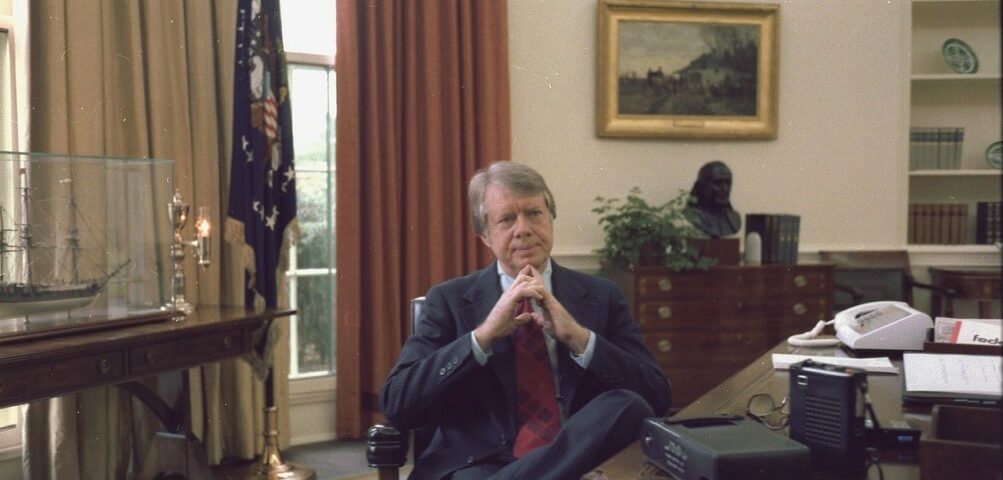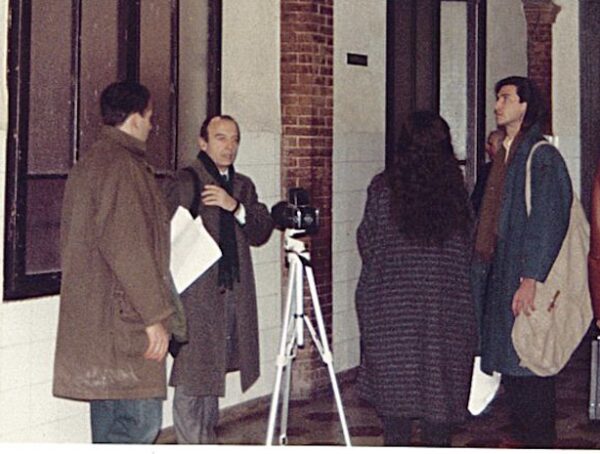
Ces 10 Libanais(es) qui nous ont redonné espoir en 2024
31 Dicembre 2024
UN ARTISTA UNA CANZONE
31 Dicembre 2024The presidency of Jimmy Carter was deeply constrained by economic and political crises. His unwillingness to take a radical stance forced him to respond to these events by imposing austerity and doing little to strengthen labor.
Whatever one might say about Jimmy Carter’s presidency, it was clear that the man himself meant for it to be transformational. From a subdued 1977 inauguration — Carter skipped the motorcade and black-tie balls in favor of business attire and an open-air stroll down Pennsylvania Avenue — to subsequent promises to restore American energy independence, reform welfare, and even transcend the “inordinate fear of communism” that had dominated US foreign policy since the 1940s, the thirty-ninth president put a lot on his plate.
Elected president in the wake of the catastrophic US intervention in Vietnam and amid divisive racial tensions and widespread economic distress, Carter hoped to, as he put it in his inaugural address, “bring a resurgent commitment to . . . basic [moral] principles” and establish a government “both competent and compassionate.”
Though Carter achieved more than he is generally given credit for — and remains among the more decent men to have held the office — his presidency failed to bring about the fundamental transformation he sought. Instead, his term helped establish a far more dubious pattern: Democratic presidents with admirably ambitious policy agendas stymied by an inability to form a durable coalition or stem the erosion of their party’s support among the working and middle classes.
Filling the Void
Born in Plains, Georgia in October of 1924, Carter at first seemed destined for a life in the navy, graduating from the Naval Academy in 1946 and serving aboard submarines until 1953. He was called home to Plains that year by family crisis — his father had died leaving the family farm in desperate straits — forcing a reluctant Jimmy (and his even more reluctant wife, Rosalynn) to return to manage it.
The lure of public service never was far away, however, and, with prosperity restored by the late 1950s, Carter turned to politics, serving in the Georgia State Senate before a failed run for governor in 1966 (he was ultimately defeated by the arch-segregationist Lester Maddox). Though Carter himself had demonstrated a personal opposition to racism that was rare among Georgia whites of his background, he proved politician enough to court white supremacists in his second run for governor in 1970, a move that may well have proved decisive in his eventual victory.
As governor, Carter returned to his more anti-racist roots, denouncing segregation, working to improve black participation in the Georgia government, and ensuring equal funding for minority school districts. His reform of the state bureaucracy is considered by many to be his main achievement while in Atlanta, demonstrating an interest in governmental “efficiency” and cost cutting that he would carry with him to the presidency. He was in many ways a post–civil rights movement resurrection of the sort of “good government” Progressive Democrats represented by figures like Woodrow Wilson.
Despite only serving a single term as governor, Carter sought the Democratic nomination for the presidency in 1976. Though no longer willing to court segregationists, Carter did prove once again eager to seem all things to all people. The New York Times that year reported that voters on the Right tended to view Carter as one of their own, as did voters on the Left — something anonymous sources on the campaign admitted was a deliberate strategy.
While a far cry from the outright campaign deception practiced by some of his immediate predecessors in office, it proved effective in allowing Carter to navigate a challenging political environment. In essence, the national debate over the Vietnam War, civil rights, and racial equality had fragmented the political coalitions formed in the 1930s and 1940s, leaving both the Democratic and Republican parties deeply divided between their conservative and liberal wings.
The rough consensus that had formed around the center-left economic policies of the New Deal and aggressive pursuit of the Cold War abroad was beginning to break down, leaving unclear what sort of new politics would follow. Carter was able to tiptoe through this minefield, pleasing enough of his party’s left and right to achieve the nomination in plenty of time to watch his opponents tear themselves to pieces during a much more protracted 1976 Republican Party primary. Ronald Reagan’s near takedown of the sitting president, Gerald Ford, as the Republican nominee certainly made life easier for Carter in the general election. Yet, given all the baggage Ford carried to the polls, Carter’s close victory (he barely carried the popular vote) offered good reason for pause.
Winding Down the Cold War
Carter plowed ahead. Deeply committed to his Baptist faith and confident in his view of the world, he moved boldly once in office to transcend what he saw as the amoral power politics that the United States had practiced over the previous few decades. The disaster of the Vietnam War, the spectacular revelations about the CIA’s misdeeds that had come to light through congressional investigations in 1975, and the ever-present danger of nuclear war meant it was time to return to what Carter believed were the nation’s moral roots: a profound respect for “human rights.” “America’s commitment to human rights,” as he put it in a 1977 speech at the University of Notre Dame, would be “a fundamental tenet of our foreign policy.”
Though a rhetorical focus, human rights were merely a convenient way to sum up a broader, harder-to-explain attempt to reorient American foreign policy. Influenced by thinkers — like his national security advisor Zbigniew Brzezinski — who feared that the world in the mid-1970s was turning away from the United States, Carter worked to burnish America’s recently tarnished reputation abroad by addressing global issues supposedly neglected by previous administrations.
First, he directly rebuked the hard-line Cold War policies that had led to the US intervention in Vietnam — announcing that the United States would continue to pursue accommodation and arms control with the Soviet Union. He also adopted a relatively more accommodating approach to the Global South’s demands in the United Nations for greater international economic equality, appointing, in a brilliant stroke, civil rights hero Andrew Young as US ambassador to the UN. His administration also made important (if incomplete) efforts to confront white supremacy in southern Africa, helping to end white minority rule in Rhodesia (today’s Zimbabwe). In addition, Carter personally negotiated what, for a time, appeared a definitive step toward peace between Israel and Palestine: the 1978 Camp David Accords.
His arguably most enduring, and today unappreciated, accomplishment was in ensuring Senate ratification of treaties restoring control of the Panama Canal Zone, and the canal itself, to Panama. By the mid-1970s, US control of the canal had lost much of its strategic value, yet was a significant embarrassment across much the world and a flash point for violence in Panama. Though all three previous administrations had made efforts to divest ownership, fierce opposition to “giving away” the canal at home had stalled the proceedings (opposing the negotiations was, in fact, a centerpiece of Reagan’s effort to unseat Ford). Carter finished the job, securing ratification by a single vote, at the cost of considerable political capital.
Indeed, Carter had something of a knack for spending his political capital without a plan for earning more. Both his wonkish focus on policy problems and his principled but often abrasive refusal to engage in the traditional horse-trading upon which Congress thrived cut into his ability to advance his administration’s agenda as his term wore on.
More critically, he offered little at home to secure the loyalty of voters struggling to make a living amid the uncertain economic climate of the mid-1970s. Admittedly, it was a difficult environment for policy makers to navigate as well, but Carter’s tendency to favor efficiency and cost cutting increasingly pulled him toward “small government” solutions. The neoliberal turn away from the more social democratic elements of the New Deal — and toward the market fundamentalism of the present — began on Carter’s watch and at his direction.
Promising early signs that the administration would work to strengthen the hand of workers and the poor faded as the president’s attention was drawn elsewhere and his preference for more conservative solutions was made clear. Staffers in the Department of Health, Education, and Welfare, for example, pushed Carter to resurrect a program for a guaranteed national income that had nearly passed Congress during Richard Nixon’s administration. Carter, however, pushed for more modest proposals, and even the watered down 1977 welfare “Program for Better Jobs and Income” never really became a priority (and was as much focused on cutting costs as increasing benefits).
A similar fate awaited legislation requiring the government to guarantee a job for all Americans, regardless of market conditions — a focus of the prolabor left since the 1940s. Proposed in 1974 by Senator Hubert Humphrey and Representative Augustus Hawkins, the bill initially required the government to provide a job if the market couldn’t. Carter proved skeptical and pushed for a more watered-down proposal in 1977. The final version of the bill, passed in 1978 as the Full Employment and Balanced Growth Act, merely required the government to pursue the goal of full employment, and in practice did little beyond increasing the number of reports the federal government provided on the economy each year.
The areas where Carter did focus his attention did little to immediately help voters either. His Energy Security Act and deregulation of fossil fuel prices likely reduced energy costs (and thus, inflation) in the long term, but like other policies — including deregulating the airline, trucking, and railroad industries — the degree this ever benefited working- and middle-class Americans is debatable.
Absent a broader effort at further realigning the inegalitarian structure of the US economy, such measures were for many Americans little more than a rearranging of the deck chairs on a sinking ship. More ominously in 1978, Carter invoked emergency provisions of the 1947 Taft-Hartley Act to break a strike by the United Mine Workers. Fearful that the strike, a mere three months old, would lead to a rise in energy costs, Carter in effect sided with management, delivering one of the first in a series of blows to the power of organized labor over the subsequent decades.
Thus when the 1979 Iranian Revolution upended the global oil market — leading to spiking prices, gas lines, and resurgent inflation — Carter had little to offer to stem the misery. Indeed, one of his solutions, appointing Paul Volcker as chairman of the Federal Reserve, offered more immediate suffering rather than less. Empowered to take inflation on directly, Volcker dramatically raised interest rates over the course of 1979 and 1980, engineering a vicious recession By the time Volcker was done (after Carter left office), inflation would subside, but so would wage growth, a reality which in effect persists to the present.
The revolution in Iran and subsequent hostage crisis — student radicals stormed the US embassy in Tehran, taking sixty-six US citizens hostage and holding most for more than a year — fatally undermined whatever reputation Carter had developed for competency on foreign policy. His sensible attempt to negotiate a peaceful solution appeared to many Americans to offer nothing but humiliation, a feeling only compounded by a failed rescue mission that left two US aircraft crashed in the Iranian desert. His efforts at lowering Cold War tensions were further undercut by the December 1979 Soviet invasion of Afghanistan.
All told, when the 1980 election season arrived, Carter had little to confront Ronald Reagan and his politically devastating question to voters: “Are you better off than you were four years ago?” The answer very clearly, very painfully, was no. Carter lost decisively.
Reagan, of course, would proceed to vastly reduce the power of the working and middle classes, securing a path to four decades of stagnating incomes, collapsing labor unions, and the vast inequality of the present. Yet, given how little Carter himself did to arrest this trend, it’s no surprise that voters, particularly working-class “Reagan Democrats,” were willing to give the Republican a try. As Stuart Hall wrote of Margaret Thatcher’s Conservative Party, Reagan’s success did not lie merely in his “capacity to dupe unsuspecting folks but in the way” he “address[ed] real problems, real and lived experiences . . . within the logic of a discourse which pulls them systematically into line with policies and class strategies of the right.” Carter’s solutions-oriented politics — lacking, as they did, substantive attempts to immediately improve the economic lives of voters by redistributing income — simply couldn’t compete.
All of his Democratic successors in the Oval Office have fallen into much the same trap. Carter’s presidency did therefore prove transformational, just not in the way he intended. Those on the Left seeking to escape the pattern Carter established should look less to his presidency, and more to his post-presidency: an admirable, long, and dedicated effort to immediately improve and elevate the lives of those suffering from depravation, illness, and want. A president pursuing such an approach in office could be transformational indeed.




